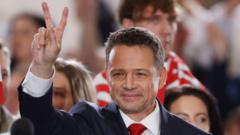The papal conclave commenced today, consisting of 133 cardinals participating in a secretive election process to appoint the next leader of the Roman Catholic Church, following Pope Francis' recent passing. This marks one of the largest gatherings in history, occurring against a backdrop of internal strife concerning the church's future direction, financial challenges, and previous scandals related to sexual abuse.
**Cardinals Commence Historic Conclave to Elect Next Pope Amid Church's Turmoil**

**Cardinals Commence Historic Conclave to Elect Next Pope Amid Church's Turmoil**
As the papal conclave begins, 133 cardinals gather to elect the successor of Pope Francis in a time of division and uncertainty within the Catholic Church.
The conclave unfolded under the awe-inspiring ceilings of the Sistine Chapel, where the cardinals gathered after attending their last public Mass at St. Peter's Basilica. As the chapel's doors closed, they recited a solemn oath to maintain the confidentiality of their proceedings—a tradition paramount to this ritual, which has taken place for centuries.
The voting, conducted in rounds, begins today but is unlikely to yield a decision immediately, requiring subsequent meetings until a two-thirds majority can be reached. Cardinal Pietro Parolin, former deputy to Pope Francis, and Cardinal Luis Antonio Tagle of the Philippines are among the leading favorites, as opinions remain deeply polarized among cardinals advocating for both progressive and conservative ideologies in the church.
The conclave not only illustrates the complexities of papal elections but also shines a light on the evolving landscape of the Catholic Church. As cardinals consider who will guide them into the future, the choice reflects broader societal issues such as inclusivity, rights, and the church's global responsibilities. Predictably, the conclave's outcome remains uncertain, as the cardinals navigate their first voting decisions together, many meeting for the first time.
As this ancient tradition serves as both a political and spiritual gathering, the weight of history and the hope for transformative leadership loom large over the Sistine Chapel. The cardinals will continue their deliberations behind closed doors until a new pope is elected, marking a pivotal moment for the Roman Catholic Church and its followers worldwide.
The voting, conducted in rounds, begins today but is unlikely to yield a decision immediately, requiring subsequent meetings until a two-thirds majority can be reached. Cardinal Pietro Parolin, former deputy to Pope Francis, and Cardinal Luis Antonio Tagle of the Philippines are among the leading favorites, as opinions remain deeply polarized among cardinals advocating for both progressive and conservative ideologies in the church.
The conclave not only illustrates the complexities of papal elections but also shines a light on the evolving landscape of the Catholic Church. As cardinals consider who will guide them into the future, the choice reflects broader societal issues such as inclusivity, rights, and the church's global responsibilities. Predictably, the conclave's outcome remains uncertain, as the cardinals navigate their first voting decisions together, many meeting for the first time.
As this ancient tradition serves as both a political and spiritual gathering, the weight of history and the hope for transformative leadership loom large over the Sistine Chapel. The cardinals will continue their deliberations behind closed doors until a new pope is elected, marking a pivotal moment for the Roman Catholic Church and its followers worldwide.




















